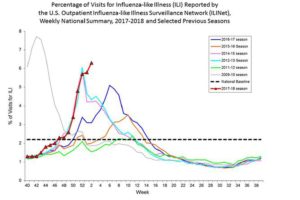News Articles

This flu season keeps getting deadlier, and a shutdown will make things worse
Mar 21st, 2018 | By: Lena H. Sun, washingtonpost.com
This post has been updated.
A bad flu season that has hit the entire continental United States has yet to peak and already has caused the deaths of more children than what normally would be expected at this time of the year, according to officials and the latest data released Friday.
During the second week of January, more people sought care for flulike illnesses than at any comparable period in nearly a decade, the Centers for Disease Control and Prevention weekly report shows. Ten children died in the week ending Jan. 13, bringing the total number of pediatric deaths this flu season to 30. More than 8,900 people have been hospitalized since the season started Oct. 1.
The flu activity indicators are notable for the sheer volume and intensity of flu that is taking place in most of the country at the same time.
“Pretty much the entire country is getting hit pretty hard at the same time,” said Lynnette Brammer, who heads the domestic influenza surveillance team at the CDC. “Flu activity is still going up.”
In addition, she said, “we’re seeing more pediatric deaths than we would expect to see at this time of year.” About 80 percent of children who die from flu were not vaccinated, she said.
A federal government shutdown could complicate CDC’s ability to know, in real time, whether flu cases are continuing to increase. Personnel like Brammer, who works in the annual influenza program, are among the 63 percent of agency employees who would be furloughed, according to the updated 2018 contingency plan from the Health and Human Services Department. Throughout CDC, more than 8,500 employees would be furloughed.
State labs would continue to operate and monitor flu activity, test specimens and send that information to the CDC. “The states would still be doing their jobs,” Brammer said. But if CDC epidemiologists and others monitoring the data are not at work, that data “would not be put together on a national level.”
Spot shortages of prescription antiviral drugs persist, she said, despite CDC’s work with manufacturers to ensure sufficient supplies. It’s not clear whether the agency personnel working on that will be able to stay on duty during a shutdown.
Just before 8 p.m. Friday, CDC spokeswoman Kathy Harben said that in the event of a shutdown, the agency would use its authority to protect life and property, and its “immediate response to urgent disease outbreaks, including seasonal influenza, would continue.” She said staff would continue to analyze data reported from state and local authorities.
But for disease surveillance activities not directly related to life-threatening situations, there would be limits on staff resources that would result in more time to review, analyze and report out public health information.
CDC would not be able to support most noncommunicable disease prevention programs, continuous updating of disease treatment and prevention recommendations, and technical assistance and other support to state and local partners, Harben said.
When the government was shut down in 2013, antiviral supplies for flu weren’t affected because the action took place in early October at the start of flu season. At the time, CDC kept on the employees who respond to an infectious disease outbreak but had to furlough those tracking and monitoring outbreaks. “It was really, really foolish,” said Tom Frieden, who was CDC director from 2009 to January 2017 and is now chief executive of a global health initiative called Resolve to Save Lives.
CDC also had to shut down many of its monitoring systems. Its central lab, normally bustling with people doing tests and producing diagnostic kits, was empty. Frieden recalls machines beeping and alarms going off. “We had hundreds and hundreds of specimens stacking up in the receiving lab,” he recalled. “We couldn’t do the testing.”
What’s more, furloughed employees were forbidden to check their emails or do work at home. “This was the one time when I thought, ‘I just don’t know if I can do my job of protecting Americans,’” Frieden said.
On Jan. 14, a 10-year-old boy from New Canaan, Conn., Nico Mallozzi, died after contracting the flu and developing a pneumonia complication while traveling to Buffalo with his hockey team, according to reports.
It’s too soon to know just how severe this flu season ultimately will be.
Officials were hoping the season had peaked in the first week of January, but the latest data show activity continued to increase into the second week. The season is closely tracking the 2014-2015 season that was dominated by the same H3N2 flu strain, an influenza A strain that generally causes the worst outbreaks. The overall hospitalization rate for the week ending Jan. 13 is now 31.5 per 100,000, up from 22.7 per 100,000 the week before.

Percentage of outpatient visits for flulike symptoms in this and previous flu seasons. Red line represents 2017-2018. (CDC)
Two other flu strains are also causing illness: H1N1, an influenza A strain that caused the 2009-2010 swine flu pandemic but is now a regular human flu virus, and an influenza B strain.
“We have a mixed bag of viruses out there,” Brammer said.
H3N2 tends to have the greatest impact on the elderly and very young, she said. H1N1 viruses don’t tend to be as bad for the elderly because those individuals were most likely exposed as children and have built up immunity; for the same reason, those viruses tend to be worse for non-elderly adults. Influenza B, which is the strain that sickened the Connecticut boy, can hit school-age children.
With all that virus out there, “there’s more chance of getting something,” Brammer said. Still, it’s impossible to forecast. “We have seen years where there is a mixed bag of viruses and nothing took off,” she said. “There’s just no hard-and-fast answer to influenza.”
The only certainty is this: With the flu season likely to last for several more months, officials and clinicians say it’s still not too late to get a flu shot.





